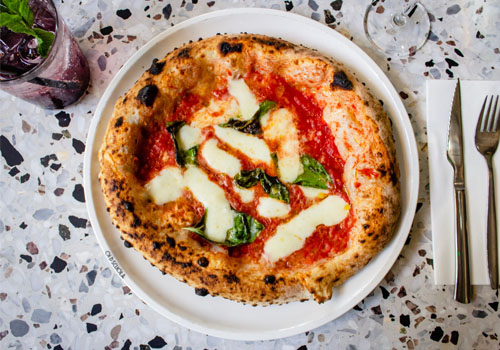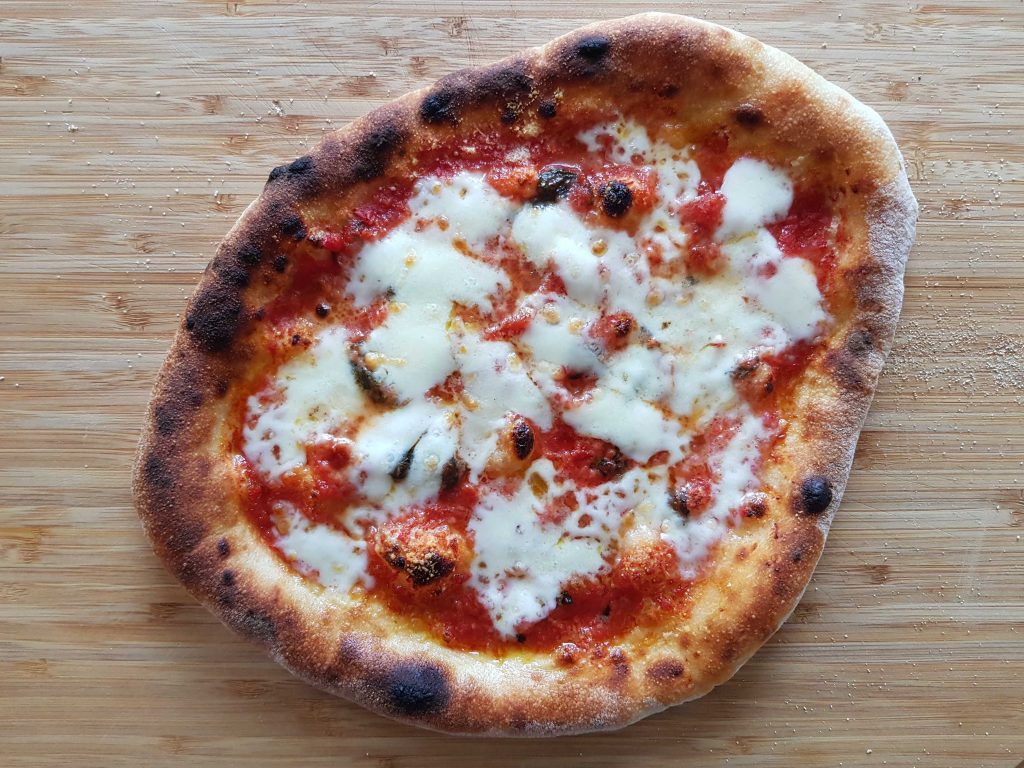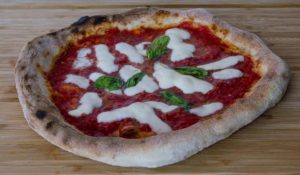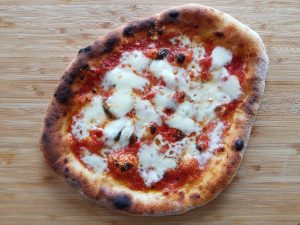Are you struggling to get the perfect leopard pizza you get in Italian pizzerias? Or perhaps you’re just wondering why the pizza you just ordered is covered with back, seemingly burnt? Then you’ve come to the right place. Here’s everything you need to know about charring and leopard pizza.
Should Pizza Crust be Charred?
You may have been served pizza that was filled with black, charred spots, and wondered if that’s how it should be or if the pizzaiolo just burned your pizza… But that’s actually how it should be. Pizza has a long history, and until recent times, it has been prepared in a blazing hot wood-fired oven. Charring of the curst is a by-product of baking in a hot oven. The charring also adds a more complex flavor to the pizza. So pizza should be charred, both on the bottom of the pizza and with a leopard pattern on the crust. It should not be burned though, there is a difference between burned and charred pizza.
What is Charring?
First, we need to talk about what charring actually is. Charring is a chemical process of incomplete combustion. This means that high heat has started turning the object into coal. It’s important to point out that we’re talking about incomplete combustion, meaning that only the surface of the object is affected, or else it would have been burned, and turned completely into coal.
In the context of pizza, charring means that the crust of the pizza is covered with small, lightly burnt spots. The high heat from baking, both from the floor of the oven and radiating heat from the ceiling contributes to charring.
Traditional Neapolitan Pizza
Traditional Neapolitan pizza is usually charred, both on the bottom and the raised edge (cornicione). Charring of the crust is almost inevitable when you’re baking the pizza in a wood-fired oven. A wood-fired
It Adds Flavor
The small, charred spots on the pizza crust add complexity to the flavor. The caramelization of the sugars in the pizza dough creates a savory and bitter flavor to the pizza. The darker the charring (closer to black), the more bitter it gets. Combined with tomato sauce and creamy mozzarella, this added savory and bitterness creates a great balanced, flavorful pizza.
How to Make Charred Pizza Crust
The main key to a charred pizza crust is heat, both over and under the pizza. When people are talking about charring pizza, they are usually referring to the charring of the crust. Charring of the edge or cornicione is often called leoparding, because it has a leopard-like pattern (more on this in the next section). I will therefore focus on the charring of the bottom of the pizza in this section.
Bake on a Hot Surface
To char the bottom of the pizza, you have to bake it on a hot surface. This is why you don’t see charring on homemade pizza, baked in a convection oven. The baking surface simply doesn’t get hot enough.
Charred pizza can generally be made in two ways: high heat or longer baking time. Either way, your baking surface needs to be able to retain and conduct heat and be of a certain temperature. The hotter the surface, the faster the pizza will bake, and the faster you’ll get charring.
Pizza Stone or Pizza Steel for Your Home Oven
If you’re using a home oven, you have to use a pizza stone or a
When it comes to charring, the higher the conductivity the better (within reason, you don’t want your pizza to burn to ashes…). I, therefore, recommend using a thicker pizza stone or pizza steel. A thicker baking surface and longer preheating times will result in more and better charring.
One thing worth mentioning is that a higher conductivity baking surface will bake, and char the pizza faster. This means that you don’t want the baking surface to be too hot compared to your oven temperature. The reason is that this will make the bottom finish before the top of the pizza. And you don’t want it to be burnt on the bottom and raw on the top! I, therefore, recommend a 3/8 – 1/2 inch
Pizza Oven
In a
According to the AVPN (The True Neapolitan Pizza Association), a Neapolitan pizza should be baked at 800-900°F (430-485°C). At this temperature, you’ll get perfectly charred pizza in 60-90 seconds. So this is generally the temperature you want to aim for when you’re baking pizza. I recommend using an infrared thermometer to make sure your baking surface has the right temperature. It will also help you detect any hot spots on the baking surface that may burn the pizza. You can read more about infrared thermometers and how to use one for your
What is Leopard Pizza?
The leopard pizza crust is a reference to the leopard-like charred pattern that you’ll find on pizza baked in wood-fired ovens. The pattern occurs when the reflected heat from the ceiling of the pizza hits the raised edge (“cornicione”) of the pizza. Bubbles and unevenness in the edge will char certain spots quicker than the rest of the edge, creating the leopard pattern.

Charred vs Leopard Pizza
Leopard is actually a type of charring, specifically referring to the leopard-like charring pattern that occurs on the cornicione of the pizza. So when I’m talking about leopard pizza, I mean this pattern on the upper part of the edge of the pizza.
What causes the Leopard pattern
To create this pattern, the edge of your pizza has to be a bit uneven or contain air bubbles from the fermentation process. When you bake the pizza in the oven, the parts that are closer to the heat will get more charred. So if your cornicione is completely even, you will also get an even browning. It should however not be necessary to try to make it uneven. This will naturally happen when shaping your pizza dough. But it’s worth keeping in mind if you’re struggling to achieve a leopard pattern on your pizza.

How to Make Leopard Pizza at Home
As already mentioned, the key to charring the pizza high heat. So whether you’re baking pizza in a home oven or a
Leopard Pizza in a Home Oven
Most home ovens can’t reach more than 500-550°F (or 250-300°C), which is significantly lower than a wood-fired oven. To achieve a leopard pattern on the cornicione, you want to increase the temperature as much as possible.
Use the Highest Temperature Possible
The first thing you want to do is to use the highest temperature your oven allows. Turn it up to the highest setting, whether it’s 450°F, 550°F, or more.
Using the Broiler
Using only convection isn’t going to be enough to create a proper leopard pattern on your pizza. You need more radiating heat from above. I recommend using the broiler or grill function to increase the heat to achieve leopard pizza.
You also want to place the pizza stone or steel as close to the broiler as possible, ideally, around 2 inches. You should therefore use the top rack. If your top rack isn’t close enough, you can place your stone or steel on an upside-down deep baking sheet.

A challenge using the broiler is that when you preheat the oven, it’s already hot, and this will cause the broiler to turn off periodically. The broiler usually turns off when the oven is at the desired temperature and turns back on when the temperature drops a few degrees.
A trick a friend of mine taught me to deal with this challenge is to turn down the temperature when you place the pizza in the oven. This allows the oven to cool down a bit. Then, turn the oven back up to the highest setting when you transfer the pizza into the oven. By doing this, the broiler will stay on more during baking.
Leopard Pizza in a Pizza Oven
Creating the leopard pattern in a
Making It’s fairly easy to make a leopard pattern on your pizza in your gas or wood-fired
You can also lift the pizza up toward the ceiling of the oven to finish it off. The closer to the ceiling you get, the higher the temperature. This can therefore help to char the pizza if e.g. the baking surface is too hot and finishes baking faster than the top.
Related
- Is Your Pizza Dough Too Dry? Here is How to fix it! - June 10, 2024
- The Ultimate Guide to the Pizza Dough Windowpane Test - June 8, 2024
- The Ultimate Guide to Autolyse Pizza Dough - June 7, 2024




I would like to know if profetional elétric oven works in order to produce leopard spots, or Just the gaz or wood?
As long as it gets hot enough it should be possible to get leaparding on the pizza in an electric oven.
Very nice article, just what I wanted to find.
wow, awesome blog.Really thank you! Awesome.
Love your site! I’ve managed to get amazing results using the Gozney Roccbox. This oven does get up to 500C if you let it – takes about 45mins but there’s a lot of practice to master this beast.
Cheers!
This really answered my drawback, thank you!